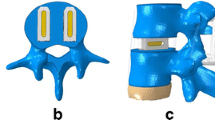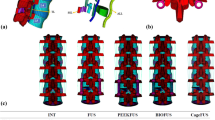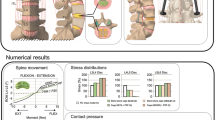Summary.
Background:
The aim of using interbody fusion cages is to distract the degeneratively decreased disc height to decompress the neural structures in the intervertebral foramina and allow bony fusion. Prerequisite for a successful fusion therapy is a high resistance against subsidence and breakage.
Method:
Three types of implants, a cylindrical threaded titanium cage (RayTM) (1c), a bullet shaped PEEK cage (StrykerTM) (1a) and a rectangular titanium cage with an endplate anchorage device (MarquardtTM) (1b) were implanted in eight monosegmental lumbar spine specimens (L 2/3 and L 4/5). Each specimen underwent a cyclic loading test with 40000 cycles at a rate of 5 Hz. A cyclic axial compression force ranging from 200 Newton [N] to 1000 N was applied and the axial translation recorded simultaneously to determine the subsidence tendency. After this procedure the specimens were tested with a progressive axial force until breakage.
Findings:
There were only small differences in the subsidence tendency for the three cage designs. The height reduction due to cyclic loading ranged between 0.9 mm (MarquardtTM), 1.2 mm (StrykerTM) and 1.4 mm (RayTM). The median break force ranged from 5486 N (MarquardtTM), 8359 N (StrykerTM) to 8413 N (RayTM). No correlation between bone mineral density and failure load could be detected.
Interpretation:
Endplate preparation and cage design of the tested implants do not seem to influence the resistance of the segment against cyclic axial compression. The compression with a continuously increasing load revealed that an implant-bone failure is not to be expected in physiological limits for all three cage types.
Similar content being viewed by others
Author information
Authors and Affiliations
Rights and permissions
About this article
Cite this article
Krammer, M., Dietl, R., Lumenta, C. et al. Resistance of the Lumbar Spine Against Axial Compression Forces after Implantation of Three Different Posterior Lumbar Interbody Cages. Acta Neurochir (Wien) 143, 1217–1222 (2001). https://doi.org/10.1007/s007010100017
Issue Date:
DOI: https://doi.org/10.1007/s007010100017




